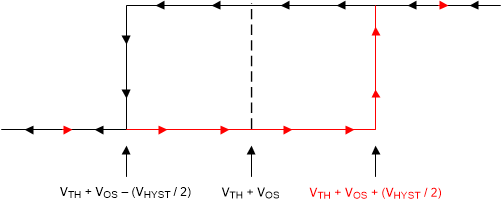ZHCSOE4B December 2022 – September 2024 TLV1851 , TLV1852 , TLV1854 , TLV1861 , TLV1862 , TLV1864
PRODMIX
- 1
- 1 特性
- 2 应用
- 3 说明
- 4 Pin Configuration and Functions
- 5 Specifications
- 6 Detailed Description
- 7 Application and Implementation
- 8 器件和文档支持
- 9 Revision History
- 10Mechanical, Packaging, and Orderable Information
6.4.2 Internal Hysteresis
The device hysteresis transfer curve is shown in Figure 6-2. This curve is a function of three components: VTH, VOS, and VHYST:
- VTH is the actual set voltage or threshold trip voltage.
- VOS is the internal offset voltage between VIN+ and VIN–. This voltage is added to VTH to form the actual trip point at which the comparator must respond to change output states.
- VHYST is the internal hysteresis (or trip window) that is designed to reduce comparator sensitivity to noise.
(2.8 mV for the TLV185x/6x family)
 Figure 6-2 Hysteresis Transfer Curve
Figure 6-2 Hysteresis Transfer Curve